In the ever-evolving space of digital marketing, few tools pack more punch than Google Ads.
Its broad and mighty reach allows companies of any scale to reach target audiences far easier than ever before.
However, if you really want to maximize the effectiveness of your ad delivery, one approach will always stand head and shoulders above the rest: ad testing.
By running different versions of ads regularly, you can identify the best-performing ones, ultimately improving your performance by reducing costs and increasing conversions.
But what exactly does ad testing entail, and how can you implement effective ad testing strategies in Google Ads?
In this post, we will explore the most important ad testing strategies that can help you optimize your Google Ads campaigns.
By investing in ad testing, you’re essentially fine-tuning your campaigns to ensure every dollar spent yields the maximum possible return.
Think of it this way: would you rather launch a campaign and hope for the best, or would you prefer to know precisely which ad outperforms, which ad connects more effectively with your audience, and which one drives desired results?
Ad testing gives you this insight, allowing you to make data-driven decisions that lead to higher performance.
Why Ad Testing is Essential for Campaign Success
Effective ad testing can be the difference between a successful and a mediocre Google Ads campaign.
By testing various aspects like ad copy, visuals, and targeting, you gain a clearer understanding of what resonates with your audience.
Not only does ad testing help improve the click-through rate (CTRClick-through rate, the percentage of people who click on an ad after viewing it.) of your ads, but it also helps reduce costs and maximize conversions.
- Improves CTR: A well-tested ad will have a considerably higher CTR because it appeals directly to what your audience is looking for.
- Reduces Costs: Testing helps you identify the best-performing ads, allowing you to allocate your budget more effectively.
- Maximizes Conversions: When you conduct ad testing, you’re more likely to discover the right combination of elements that lead to higher conversion rates, making your campaign much more profitable.
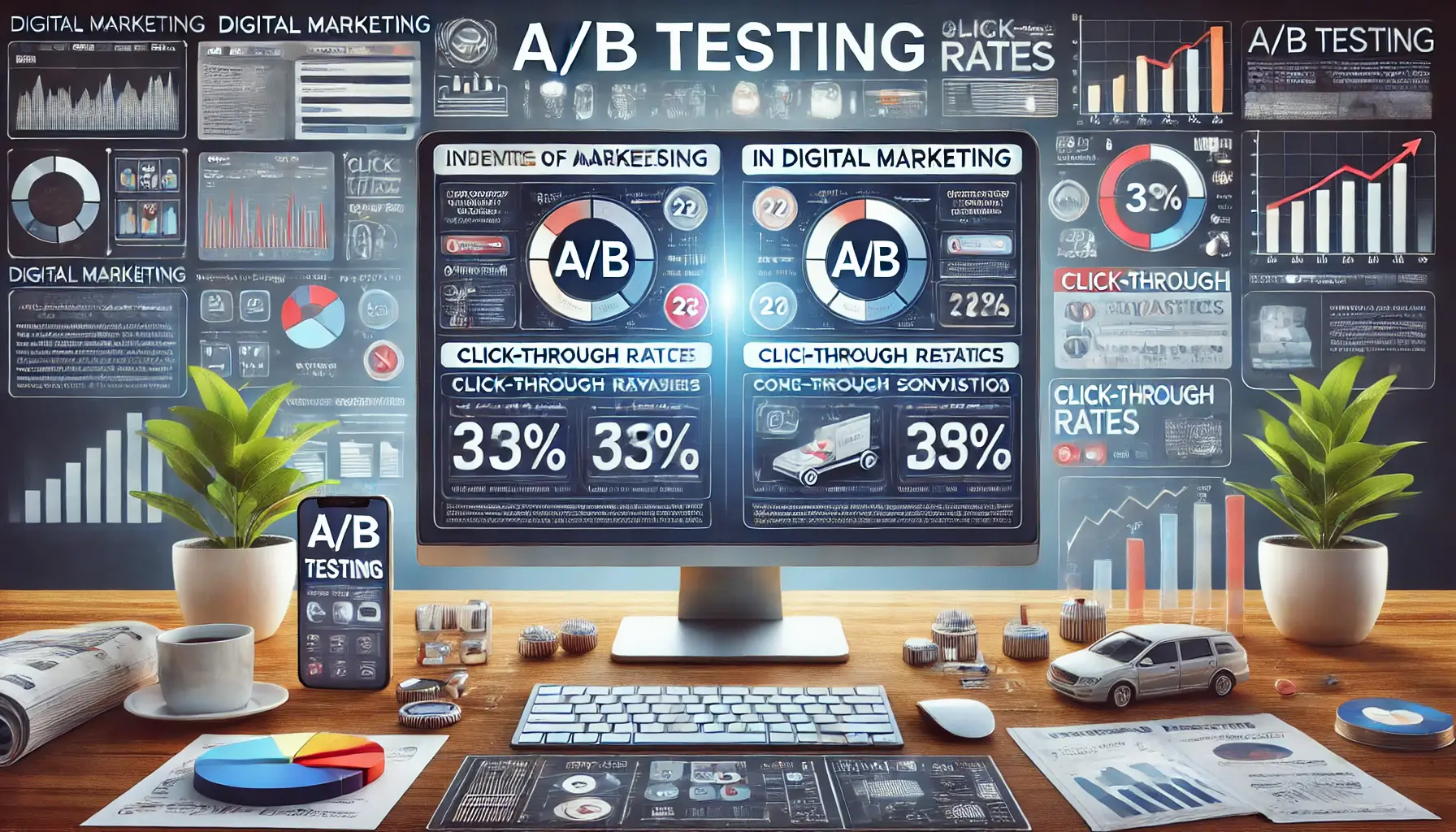
Understanding A/B Testing for Ad Optimization
The Role of A/B Testing in Optimizing Ad Performance
A/B testing is one of the most popular methods used in ad testing.
It involves running two different versions of an ad to see which one performs better.
A/B testing is particularly useful for testing specific variables, such as headlines, descriptions, or even the call-to-action (CTA) button.
For example, if you run an e-commerce store, you can A/B test two ad copies—one focused on product features and another focused on customer benefits.
Over time, you’ll gather valuable data about which messaging resonates more with your audience.
This data will help you create better ads that drive results.
One of the key advantages of A/B testingA method of comparing two versions of an ad to determine which one performs better. is the ability to optimize your ads incrementally, providing ongoing opportunities to refine and improve based on real-time feedback.

Exploring Various Types of Ad Tests in Google Ads
- Types of Ad Tests You Can Run in Google Ads
- Key Metrics to Track During Ad Testing
- Best Practices for Effective Ad Testing
- Tools and Techniques for Running Seamless Ad Testing in Google Ads
- How to Nail Ad Testing Strategies for Optimal Results in Google Ads
- Some Frequently Asked Questions About Ad Testing in Google Ads
Types of Ad Tests You Can Run in Google Ads
This may seem pretty straightforward, but when it comes to specifics, there are countless ways you can test your campaigns to optimize performance in Google Ads.
Ad testing goes beyond simple A/B testing; there are several types of tests that you can run to learn which ad elements resonate best with your target audience.
By running various types of ad tests, you can gain a comprehensive understanding of your ads’ performance and improve everything from creative decisions to targeting strategies.
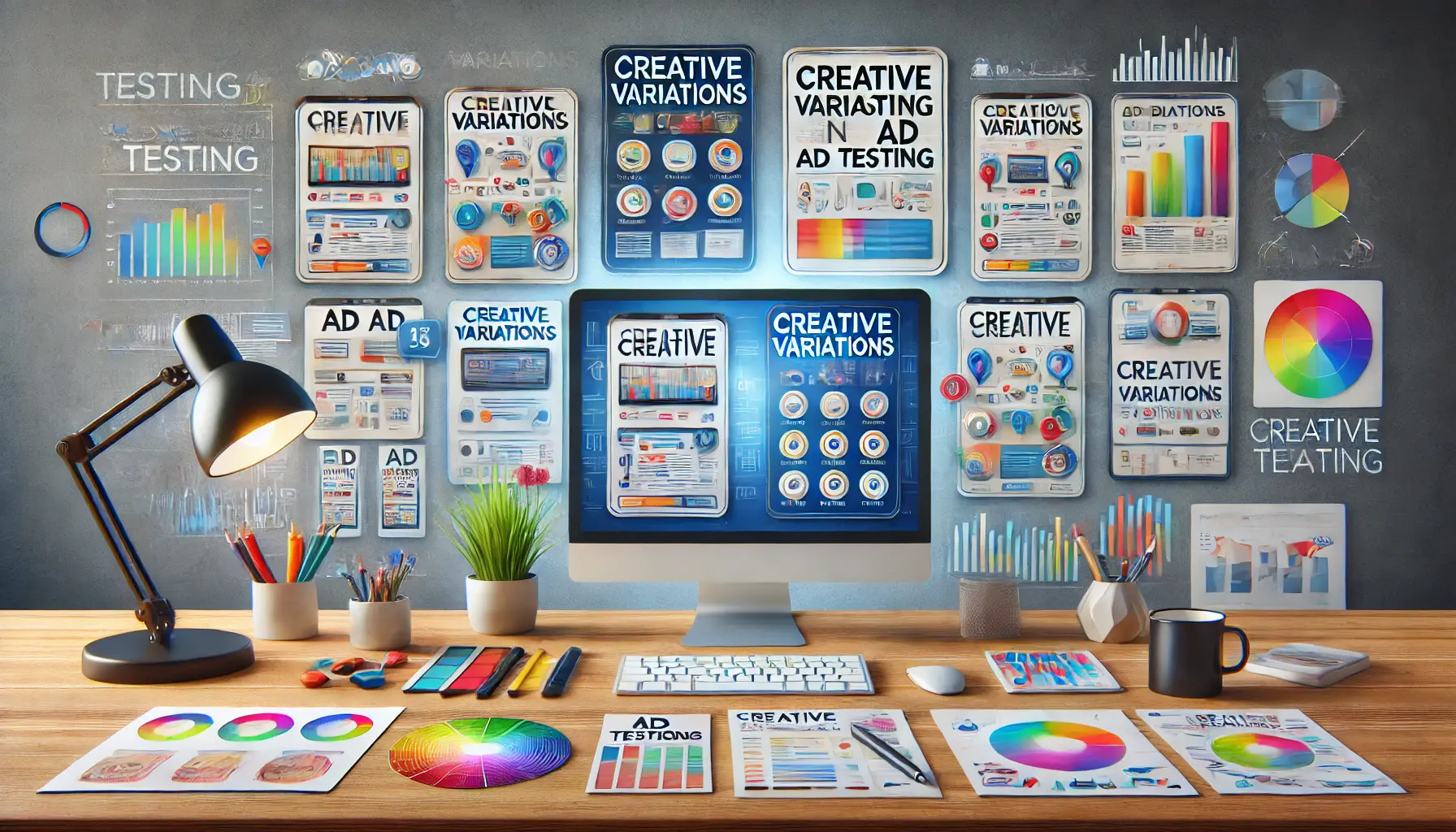
Exploring Creative Variations in Ad Testing
Creative Variations: Testing Ad Copy and Visuals
One of the most common ad testing methods is running creative variations, which involve different ad copies and visuals.
This will help you understand which messaging and design elements stand out and attract higher engagement rates.
In Google Ads, you can test the following:
- Ad Headlines: Try different versions of headlines to determine which ones capture your audience’s curiosity or provoke clicks. Test various tones, such as formal versus casual, or questions versus statements.
- Descriptions: This is your chance to provide more information. Test benefit-focused descriptions, feature-driven descriptions, and limited-time offers.
- Visuals: If you’re using display or video ads, test different images, video thumbnails, or branding elements to see which ones drive more interest.

Understanding Audience Segmentation for Effective Targeting
Audience Segmentation: Testing Targeting Strategies
Another important part of improving the performance of your Google Ads campaigns is audience segmentation testing.
This allows you to discover which segments of your audience respond more positively to your ads and which targeting strategies deliver the best return on investment.
You can segment your audiences by:
- Demographics: Test different age groups, genders, and income levels to see which segments are most likely to engage with your ads.
- Geolocation: Experiment with different geographic locations to optimize for local preferences or regional trends.
- Behavioral Targeting: Use Google’s targeting options to test audiences based on online behaviors such as past purchases, search history, or online interests.

Exploring Optimal Bid Strategies for Ad Campaigns
Bid Strategies: Finding the Optimal Bidding Approach
There is also a variety of bid strategies you can try in Google Ads to find what works best for your campaigns.
The bidding strategy you choose will significantly impact the overall cost and performance of your ads.
Test different bidding methods, such as:
- Manual CPC: Set and test manual bids to determine how varying the amount you’re willing to pay for each click affects performance.
- Enhanced CPC: Google automatically adjusts your manual bids based on the likelihood of a conversion. Testing this option will show if automated bidding improves your ROI.
- Target CPA: Set a target cost per acquisition and allow Google to optimize bids to meet that goal. Testing this method helps you balance costs and conversion rates effectively.
By testing these different elements in your Google Ads campaigns, you can gather valuable insights into what works best for your business and continuously optimize your ad strategy.
Creative variations and audience segmentation are two essential types of tests that give advertisers insight into performance by comparing different ad elements.

Monitoring Key Metrics for Effective Ad Testing
Key Metrics to Track During Ad Testing
When running ad tests in Google Ads, tracking the right metrics provides valuable insights into how effective your campaigns are likely to perform.
These metrics help you make educated decisions on which ad variations to retain, refine, or even eliminate.
Monitoring these performance indicators not only reveals which elements work best but also highlights areas where improvement is needed.
Let’s dive into the main metrics to track during ad testing.

Understanding Click-Through Rate (CTR) in Digital Marketing
Click-Through Rate (CTR)
One of the most important metrics to track during ad testing is the click-through rate (CTR).
CTR refers to the percentage of people who click on your ads after seeing them.
A higher CTR indicates that your ad is relevant and appealing to your audience.
Monitoring CTR helps you understand which ad variations attract more clicks and allows you to optimize your ads effectively to engage potential customers.
CTR is one of the best indicators of how well your ad copy, headlines, and overall messaging are performing.
To optimize CTR, test different headlines, descriptions, and CTAs to discover what resonates with your target audience.
If your CTR is low, it could indicate that your ad is not compelling enough or is not being displayed to the right audience.

Optimizing Conversion Rates Through Effective Testing
Conversion Rate Optimization Through Testing
Conversion rate is another key metric that measures the percentage of users who clicked on your ad and completed a desired action, such as making a purchase, signing up for a newsletter, or filling out a form.
While CTR tells you how well your ad is catching the user’s attention, the conversion rate helps determine whether the ad is leading to meaningful outcomes.
When testing ad variations, pay close attention to how each variation impacts the conversion rate.
A high CTR combined with a low conversion rate may indicate that, while your ad generates engagement, it is not aligned with user intent or lacks a strong post-click experience.
Ensure that the landing pages associated with your ads are optimized for conversions.

Understanding CPC and CPA for Effective Ad Management
Evaluating Cost Per Click (CPC) and Cost Per Acquisition (CPA)
Cost metrics are crucial for understanding the efficiency of your ad testing.
Cost-per-click (CPCCost per click, the amount you pay each time someone clicks on your ad.) measures how much you pay each time someone clicks on your ad, while cost-per-acquisition (CPACost per acquisition, the cost of acquiring a customer through your ad campaign.) represents the cost of acquiring a customer.
During ad testing, track both CPC and CPA to ensure your campaigns are cost-effective.
- Cost Per Click (CPC): Test different bidding strategies and ad placements to find the most cost-effective approach with good performance. A lower CPC means you’re driving traffic at a cheaper cost, but it should also align with other performance metrics like CTR and conversion rate.
- Cost Per Acquisition (CPA): This metric focuses on the cost of acquiring a customer. Tracking CPA helps you determine whether your ad tests lead to profitable customer acquisition. Optimize your ads to lower CPA without compromising the quality of your leads.
By monitoring these metrics closely, you can continuously improve your ad testing strategies in Google Ads, ensuring your campaigns drive maximum ROI while staying within budget.
Tracking metrics like CTR, CPA, and conversion rate provides valuable insights into ad performance and helps in optimizing strategies for better results.
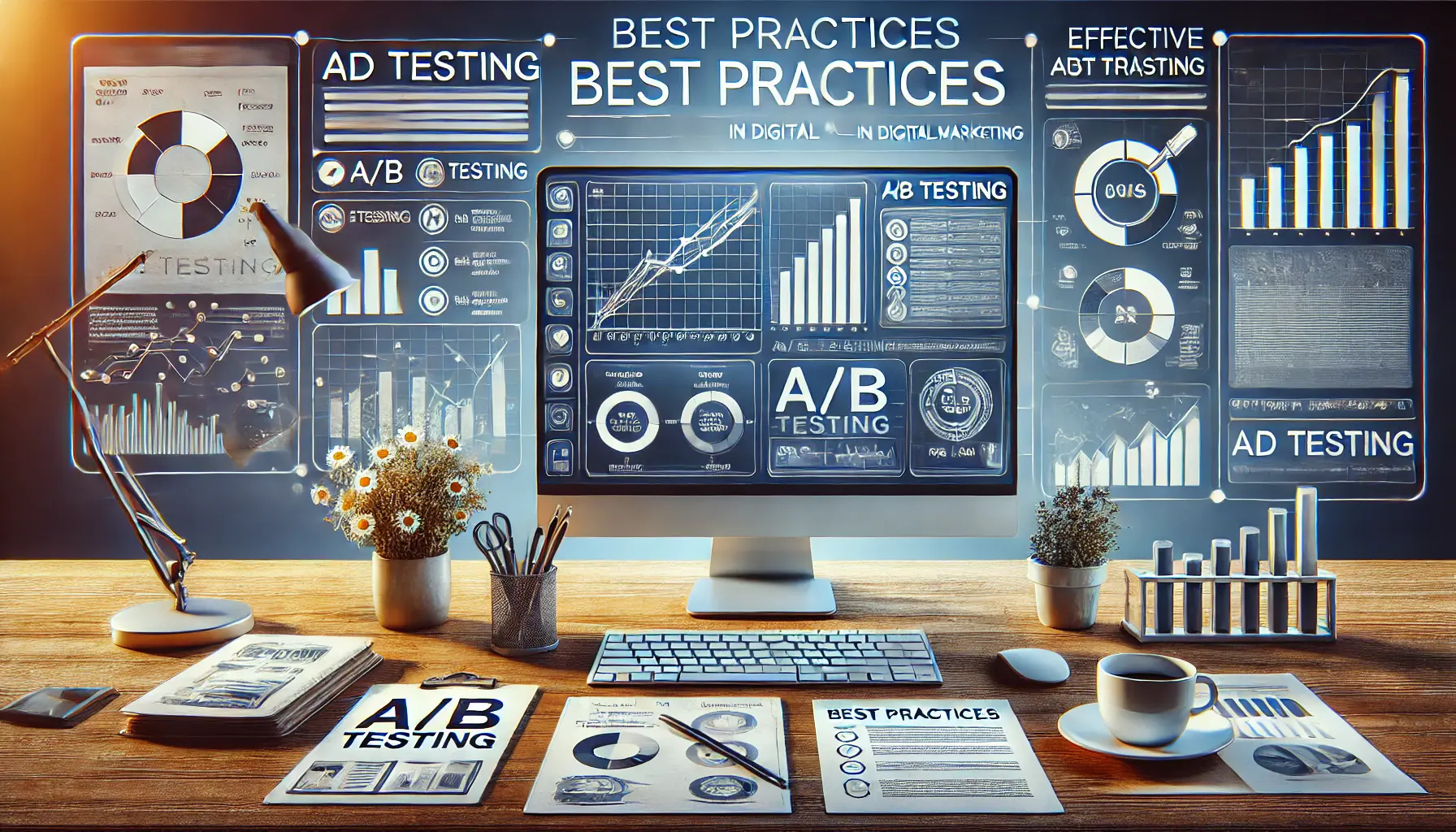
Implementing Best Practices for Successful Ad Testing
Best Practices for Effective Ad Testing
Ad testing is one of the most important activities to ensure the maximum effectiveness of your Google Ads campaigns.
By following best practices, you can ensure that your tests are controlled, accurate, and provide actionable insights that improve your campaign performance.
Implementing these strategies will allow you to fine-tune your ads more efficiently and get the most out of your ad testing efforts.

Implementing Controlled and Scalable Testing in Digital Marketing
Set Up Controlled and Scalable Tests
The first step to effective ad testing is to ensure that your tests are controlled and scalable.
Start by testing one variable at a time, such as headlines, ad copy, or targeting.
This will help you understand which exact element has driven the change in performance.
When you test more than one element at once, it can be complex to determine which specific factor had the greatest impact on your results.
Additionally, make sure that your tests are scalable.
Run ad tests across various campaigns, ad groups, and audiences.
This will expand your dataset and make the results more reliable, helping you make data-driven decisions for future ads.

Isolating Variables for Accurate Testing Results
Test One Variable at a Time for Accurate Results
One of the cardinal rules of ad testing is to test one variable at a time.
Whether it’s the headline, the call to action, or the bidding strategy, testing only one variable per test allows you to pinpoint exactly what’s working and what’s not.
Testing multiple variables simultaneously can result in inconclusive outcomes, making it difficult to optimize your campaigns effectively.
For example, if you want to test headlines, keep other elements of the ad identical.
Once you’ve gathered sufficient data to evaluate the headline’s performance, you can then move on to testing other variables, such as images or calls to action.

The Importance of Duration in Testing
Run Tests for a Sufficient Duration
Another best practice is to run your ad tests for a sufficient duration.
You need to give your ads enough time to gather reliable data, especially when testing clicks and conversions.
Rushing a test can lead to inaccurate conclusions because you may not have captured enough data to see the full impact of the changes.
As a general rule, run tests for at least two weeks, depending on your ad spend and the volume of impressions and clicks.
This helps ensure that your results are statistically significant and provide a clear view of what’s working in your campaigns.
By applying these best practices, you can ensure that your ad testing efforts in Google Ads are methodical and reliable, driving more effective campaigns.
Following best practices like testing one variable at a time and running tests for a sufficient duration is key to accurate and actionable results.
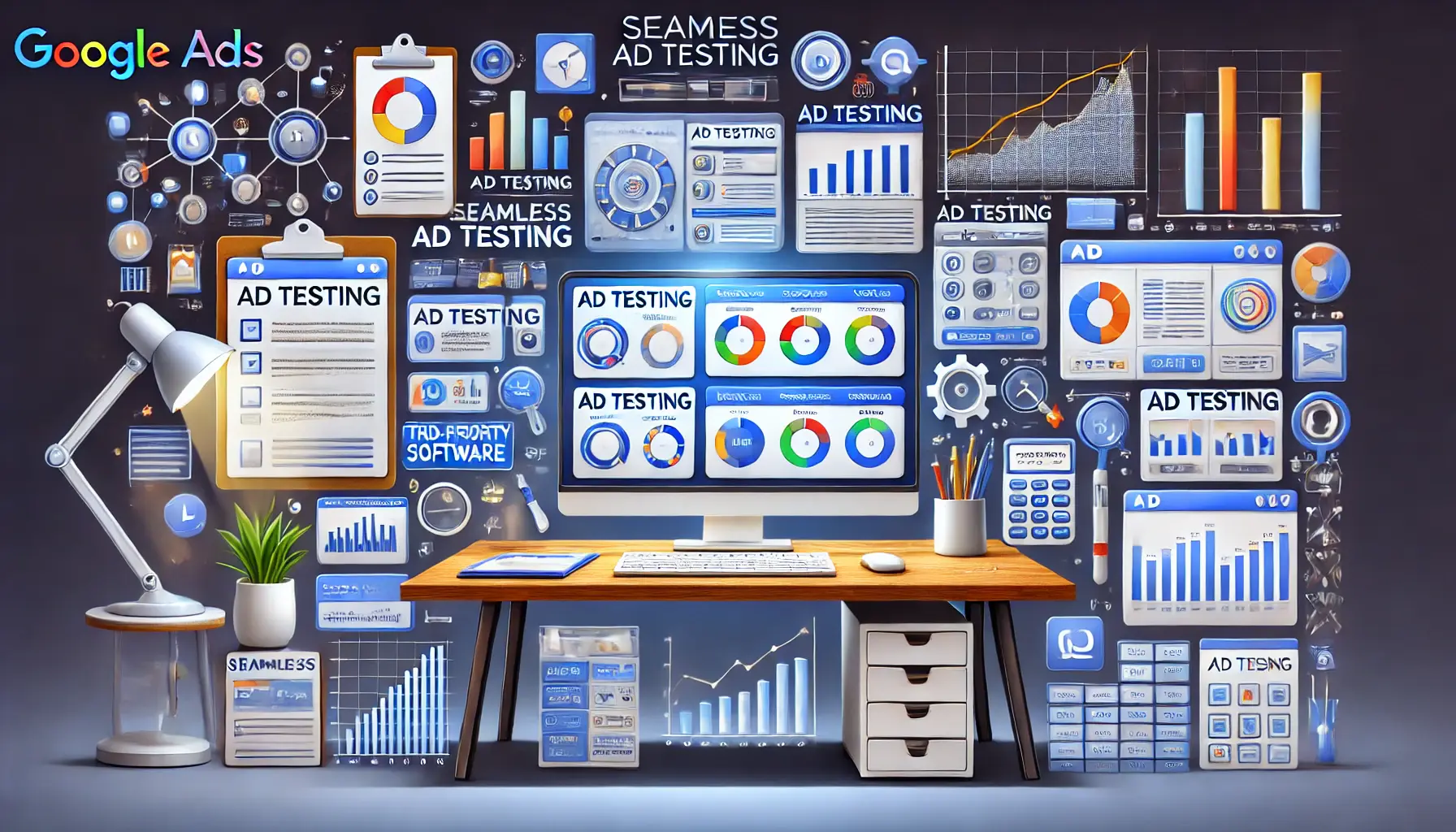
Utilizing Tools and Techniques for Effective Ad Testing
Tools and Techniques for Running Seamless Ad Testing in Google Ads
You can effectively run ad testing in Google Ads by using the right tools and techniques.
These tools allow you to conduct controlled experiments, analyze results, and refine your ads using data-driven insights.
Whether you use native Google features or third-party tools, having the proper setup will help make the ad testing process more efficient and seamless.

Utilizing the Google Ads Experiment Feature for Effective Split Testing
How to Use Google Ads Experiment Feature for Split Testing
One of the most powerful features within Google Ads is the Experiment feature.
This split test tool, also called an A/B test, allows you to run two or more variants of the same campaign or ad group to see which one performs best.
With this feature, you can easily track key metrics such as CTR, conversions, and ROASReturn on ad spend, a metric that measures the revenue generated for every dollar spent on advertising. to make data-driven decisions for optimization.
- Experiment with variations: Use the Google Ads Experiment feature to test different keywords, ad copy, or bidding strategies to see how changes impact your campaign’s performance.
- Data-driven insights: The Experiment tool automatically collects data and visualizes insights, helping you select the best-performing variations of your ads.
- Adjusting based on results: After gathering data, you can quickly adapt your campaigns based on test outcomes to improve performance.

Utilizing Third-Party Tools for Enhanced Ad Testing Strategies
Leveraging Third-Party Tools for Advanced Ad Testing
Many advertisers also use third-party tools to enhance their ad testing capabilities.
These platforms often offer more advanced features, detailed analytics, and integrations that make the process smoother.
Popular third-party tools for ad testing include:
- Optmyzr: This tool offers advanced features for ad testing, including automation of A/B testing and real-time performance analysis across variations. It also helps identify opportunities to improve ad performance with actionable insights.
- Unbounce: With Unbounce, you can build and test high-converting landing pages and optimize the post-click experience to improve conversion rates.
- Adalysis: Designed for automating and managing split tests, Adalysis provides in-depth reporting and granular insights on ad performance to help refine your ad testing strategy.

Using Test Results to Optimize Future Marketing Campaigns
Analyze Test Results to Inform Future Campaigns
Once you’ve run your tests using the Experiment tool or third-party platforms, analyzing the results becomes crucial for improving future campaigns.
Monitor performance metrics such as CTR, conversion rate, and CPA to determine which ad variations worked best and why.
- Identify patterns: Look for trends in the successful tests, such as keywords, messaging, or audience segments that consistently perform well.
- Refine future tests: Use insights from these tests to inform your next round of ad testing, ensuring that your campaigns continually improve.
- Implement winning variations: Once you identify the best-performing variations, apply them to other campaigns or ad groups to maximize their impact.
By using the right tools and analyzing your ad tests effectively, you can ensure that your Google Ads campaigns continuously improve and deliver better results over time.
Using tools like Google Ads Experiments and third-party options such as Optmyzr and Unbounce streamlines testing and optimizes ad performance.
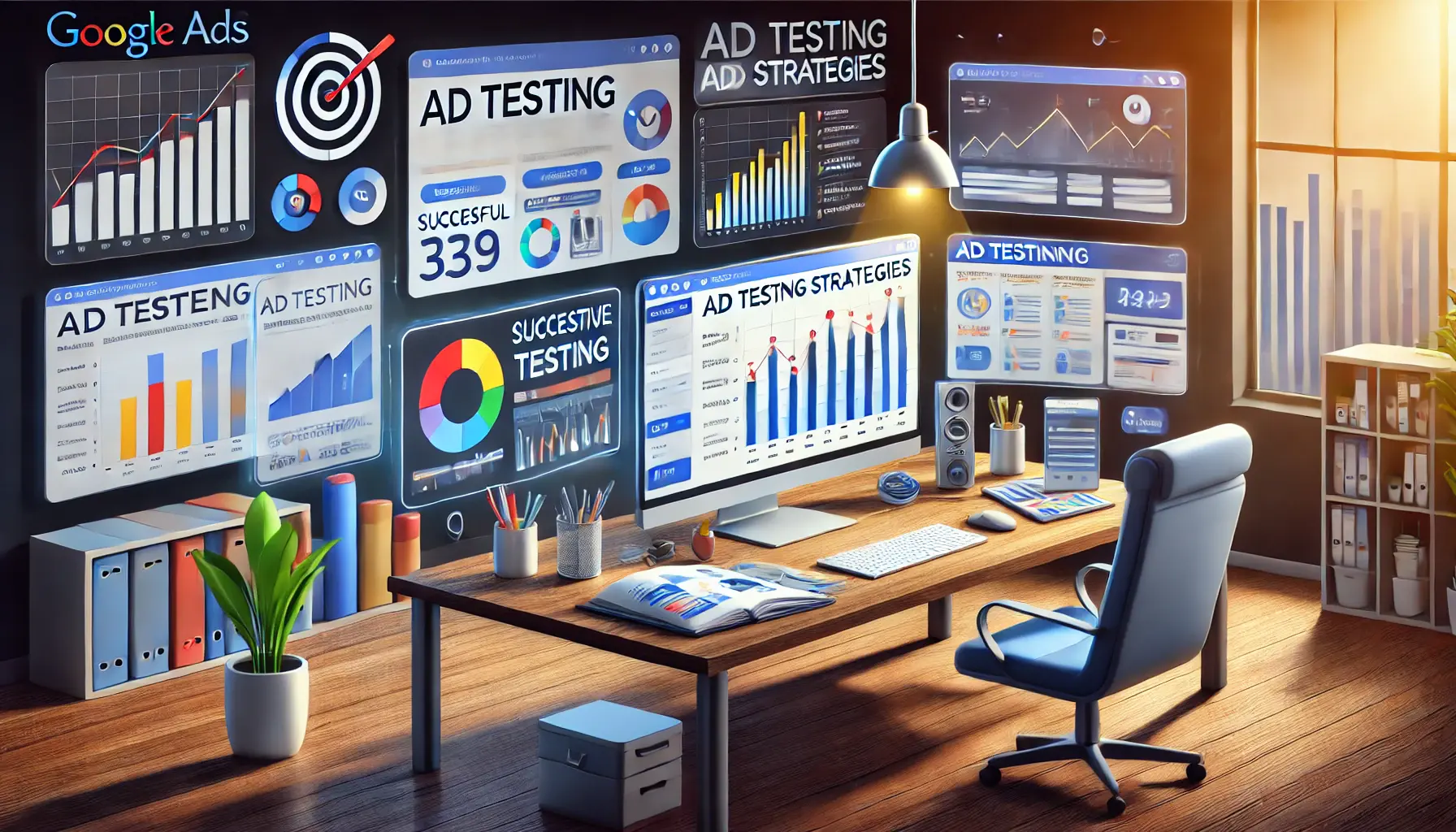
Implementing Effective Ad Testing Strategies for Success
How to Nail Ad Testing Strategies for Optimal Results in Google Ads
In today’s highly competitive digital landscape, mastering ad testing strategies in Google Ads is key to achieving the best outcomes for your campaigns.
Thoughtful and systematic ad testing enables you to fine-tune your ads, reduce costs, and increase conversion rates.
Through careful planning, execution, and analysis, ad testing brings you closer to precision targeting, better performance, and ultimately, better ROI.
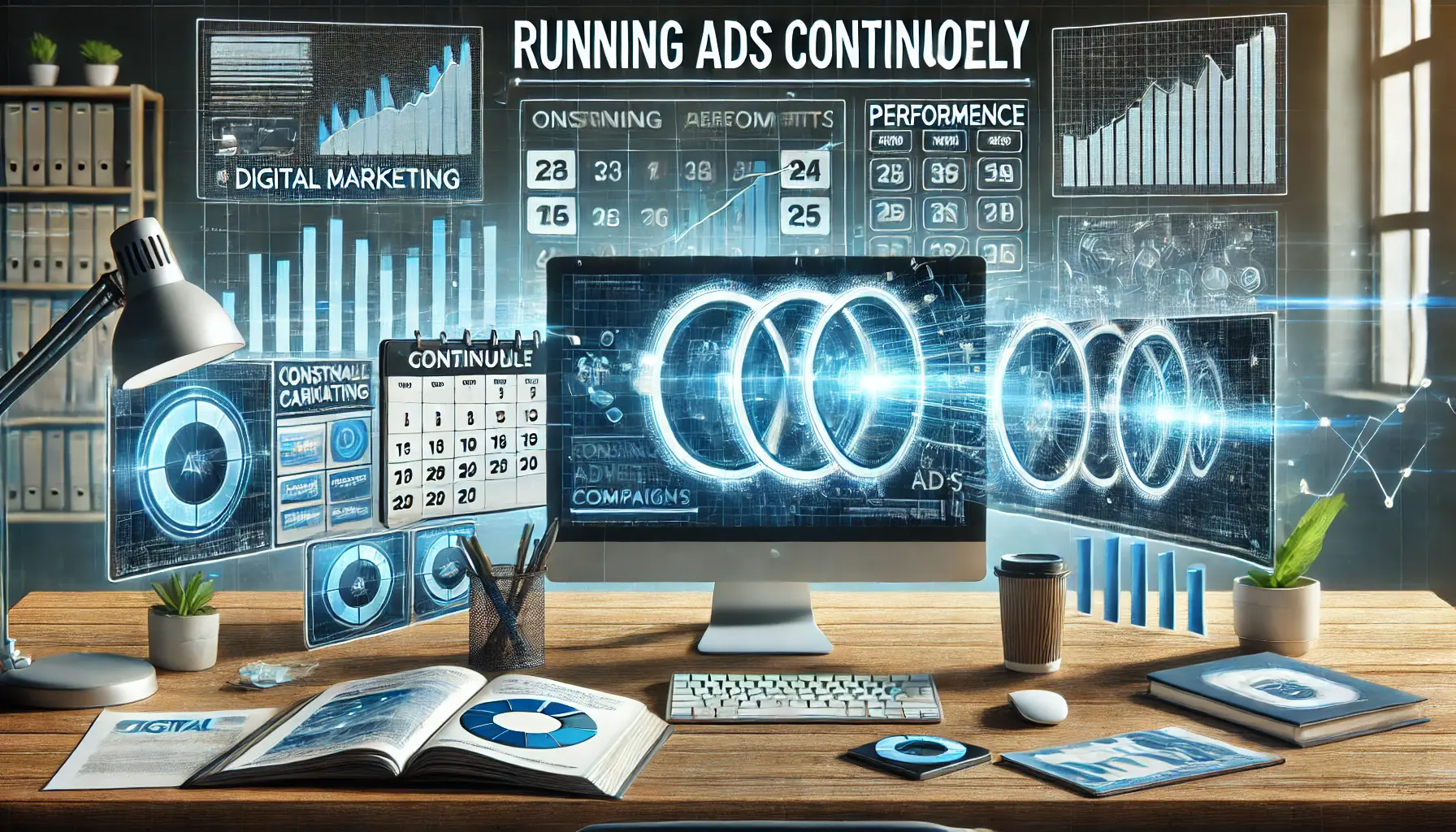
The Significance of Continuous Advertising Efforts
Importance of Running Ads Continuously
Running ad tests in Google Ads is not a one-time effort, but a continuous process that allows you to adapt to ever-changing audience behaviors and trends.
By frequently testing various ad elements—such as headlines, descriptions, visuals, and targeting strategies—you can keep your ad campaigns fresh and relevant.
This ongoing methodology helps you identify which ad variations work best and which ones fail to resonate with your target audience.
Native features like Google Ads Experiments allow you to easily conduct split-testing campaigns, while third-party tools like Optmyzr, Unbounce, and Adalysis offer advanced methods to refine your approach.
Together, these tools keep your ad testing efficient and informative, enabling data-driven decisions to drive improvements.

Emphasizing Key Metrics for Effective Campaign Optimization
Focus on Key Metrics for Optimization
When running ad tests, it’s important to focus on key performance metrics such as click-through rate (CTR), conversion rates, and cost per acquisition (CPA).
These metrics help determine the best-performing ad variations.
By observing patterns in your successful campaigns, you can further refine future tests and maintain a continuous path of ad optimization.
Insights gained from deep analysis will also enable you to apply winning variations to new campaigns, driving ongoing growth and improvements.

Implementing Best Practices for Ongoing Success in Digital Marketing
Best Practices for Continued Success
To fully reap the benefits of ad testing, it’s essential to follow best practices such as testing only one variable at a time, running tests for a sufficient duration, and scaling across multiple campaigns and audiences.
By adhering to these guidelines, you’ll gather meaningful data that leads to actionable insights, ultimately boosting the performance of your Google Ads campaigns.

Reflecting on Insights Gained from Ad Testing
Final Thoughts on Ad Testing in Google Ads
In conclusion, ad testing is an indispensable part of any successful Google Ads strategy.
It provides valuable insights into audience behavior, enables more effective targeting, and allows you to optimize both costs and conversions.
Whether you’re using native Google Ads features or third-party tools, the key to successful ad testing lies in consistent execution and thorough analysis.
This approach will help you continuously adjust and improve, leading to long-term success in your Google Ads campaigns.
Continuously running ads and monitoring key performance metrics ensures long-term success and improves ad campaign effectiveness.
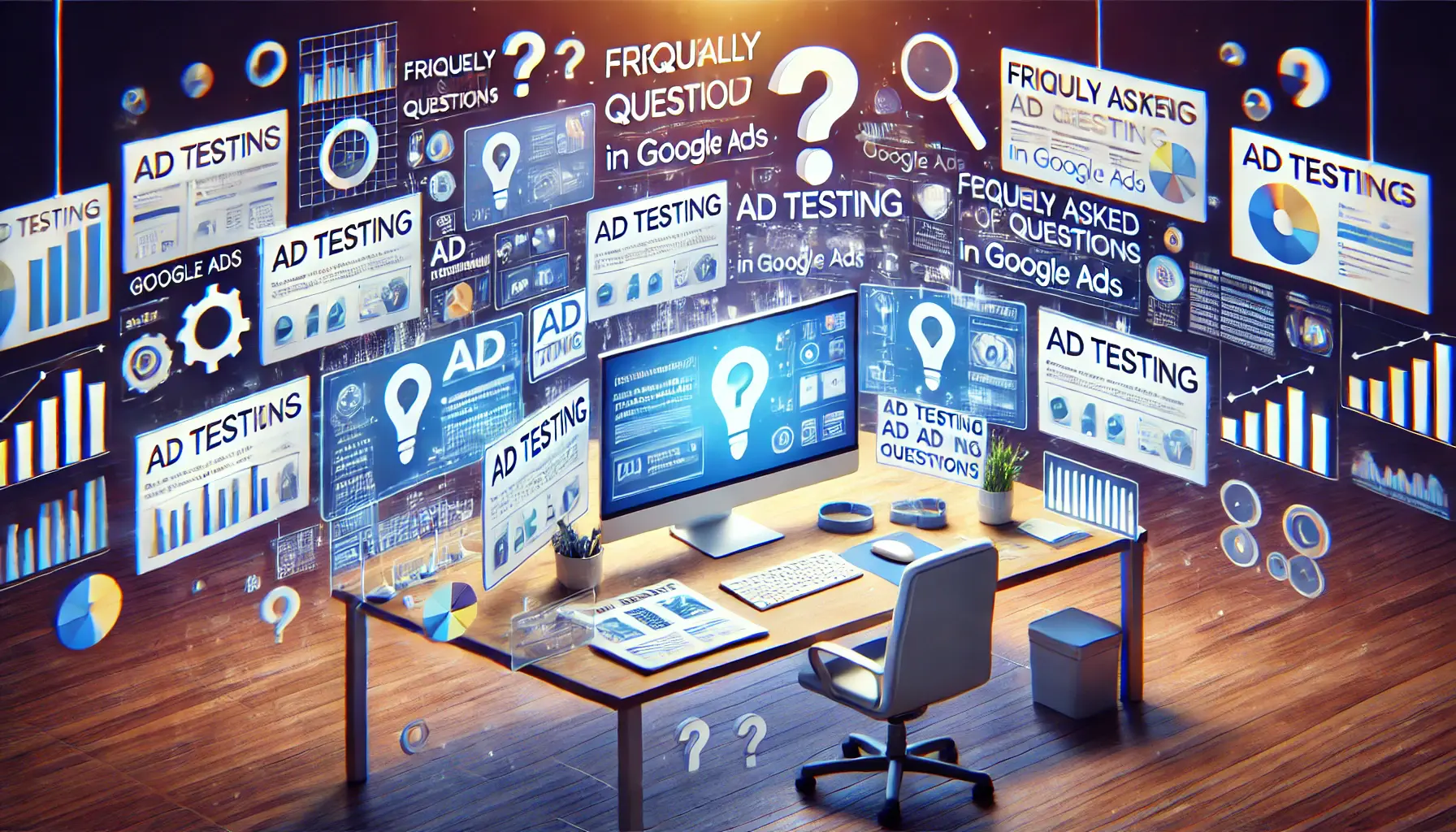
Addressing Common Queries About Ad Testing
Your campaigns can be managed by an agency specialized in Google Ads, check out our service page.
Some Frequently Asked Questions About Ad Testing in Google Ads
Below are some of the most frequently asked questions regarding ad testing strategies in Google Ads and how they help improve campaign performance.
Ad testing in Google Ads involves running variants of your ads to determine which one performs best.
This helps you optimize your ads by testing elements like headlines, descriptions, and targeting strategies.
Ad testing helps create better ads by identifying the best combinations of ad copy and targeting.
This leads to higher click-through rates and conversions, making your campaigns more successful.
The key metrics to track during ad testing include CTR, conversion rate, and CPA.
These indicators reveal how well your ads are performing and help identify areas for optimization.
Running tests regularly helps keep your ads relevant and performing at their best.
Frequent testing of different ad elements allows you to adapt to changing audience behaviors and trends.
Google Ads offers native tools such as the Experiment feature for split testing.
Additionally, third-party tools like Optmyzr, Unbounce, and Adalysis provide advanced functionality for ad testing and performance analysis.
Ad tests should run for at least two weeks to gather sufficient data for accurate analysis.
Tests shorter than this may produce unreliable results, making it harder to optimize your campaigns effectively.
Yes, ad testing helps reduce ad spend by optimizing your campaigns to focus on the best-performing variations.
This ensures your budget is spent more efficiently on ads that deliver the highest returns.
It’s best to test one element at a time, such as the headline or call-to-action.
This allows you to pinpoint which change is driving performance, making your tests more accurate and actionable.
Google Ads Experiment enables you to conduct A/B testing across variants of ads.
It provides data-driven insights on which ads perform better, helping you make informed decisions to improve your campaign.














